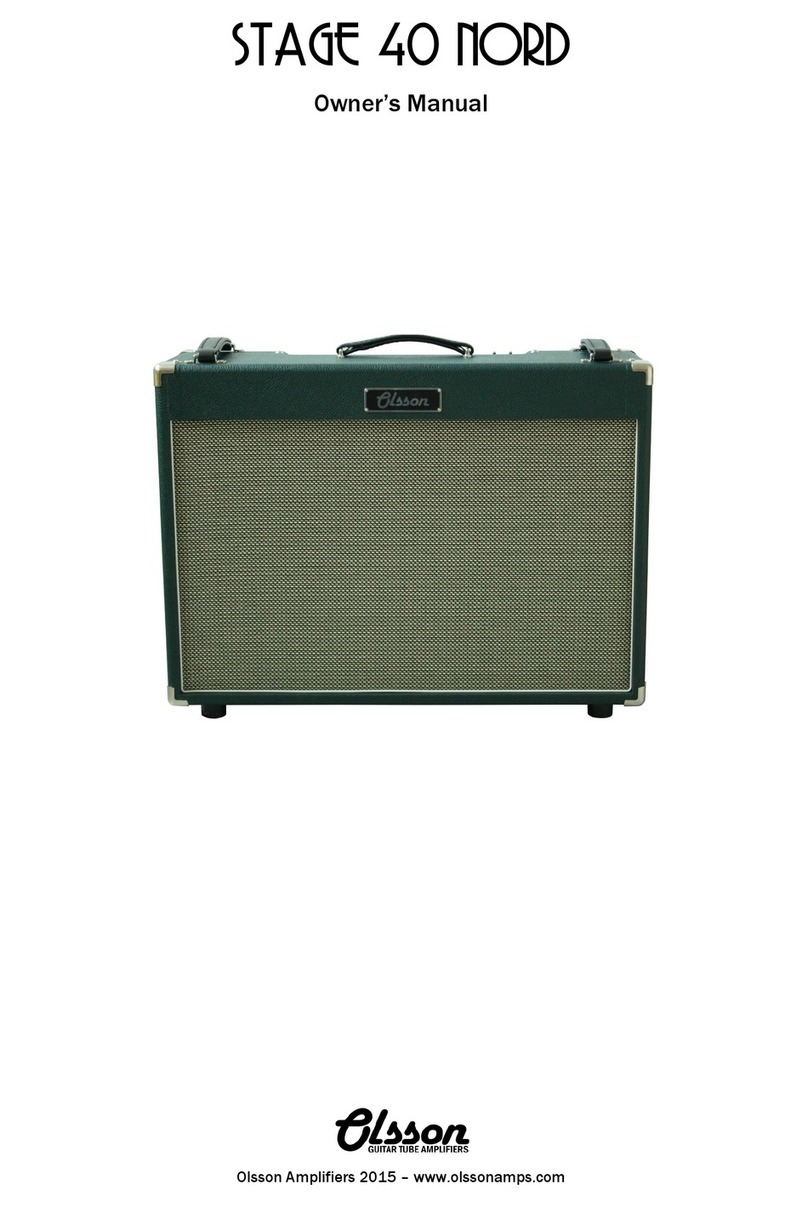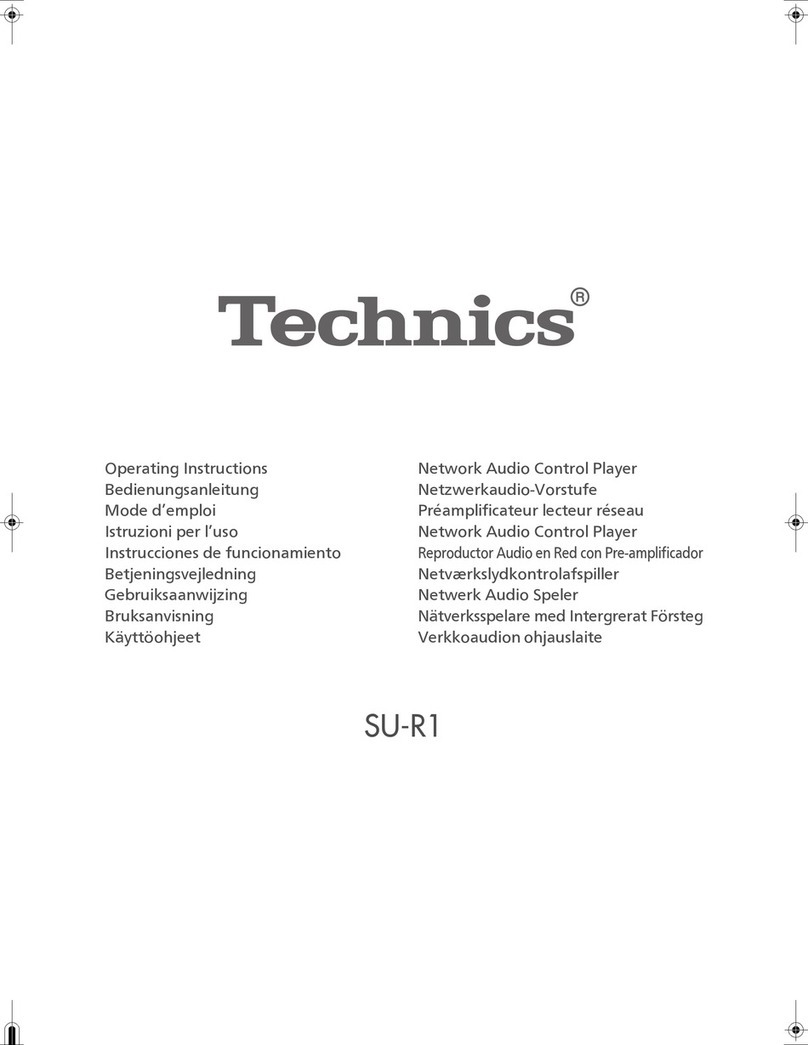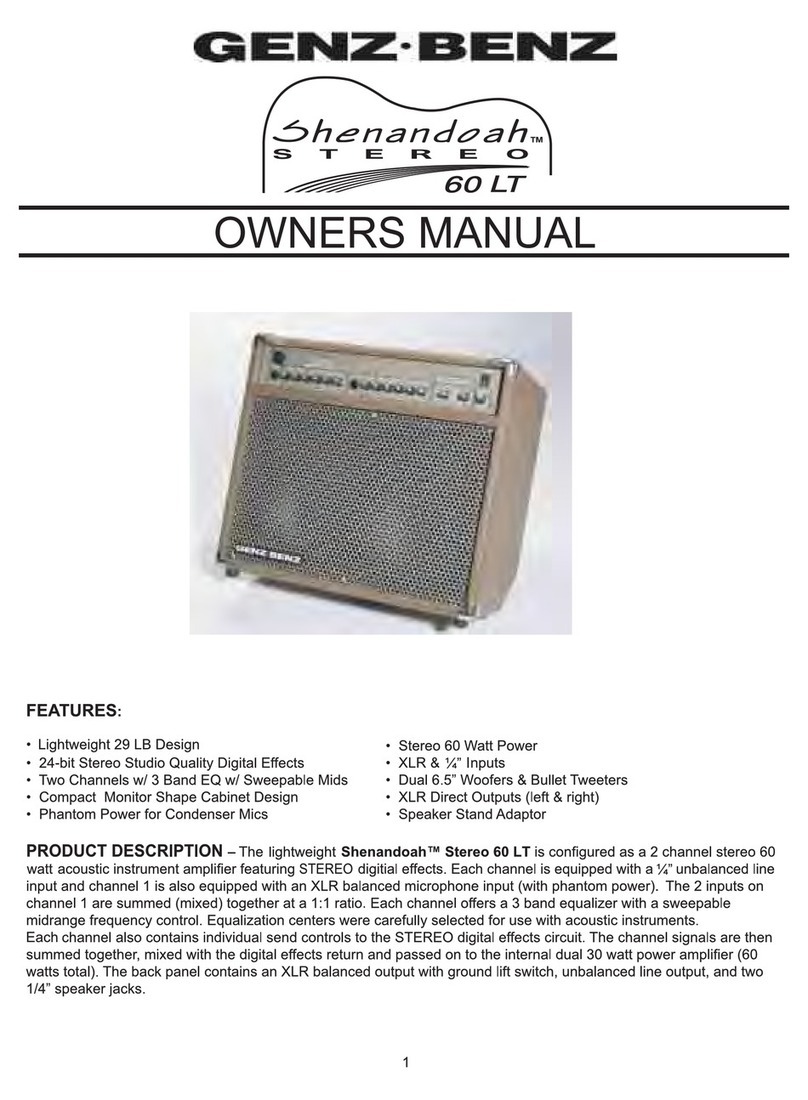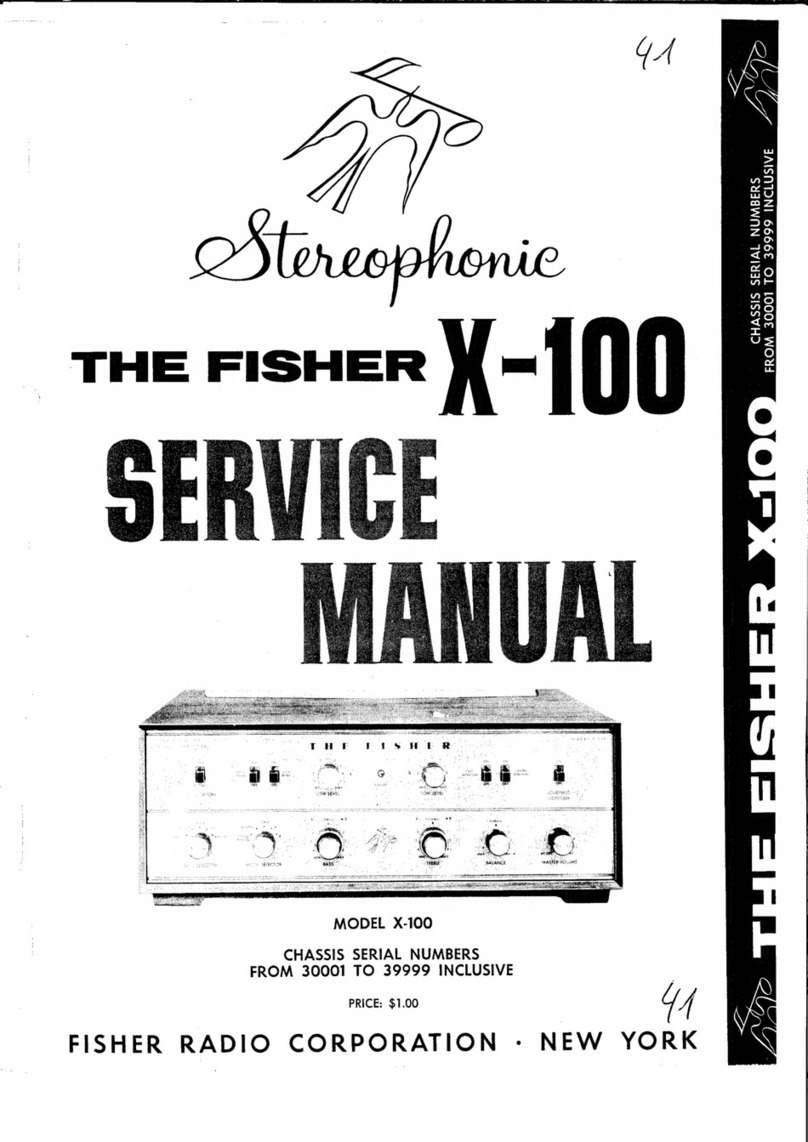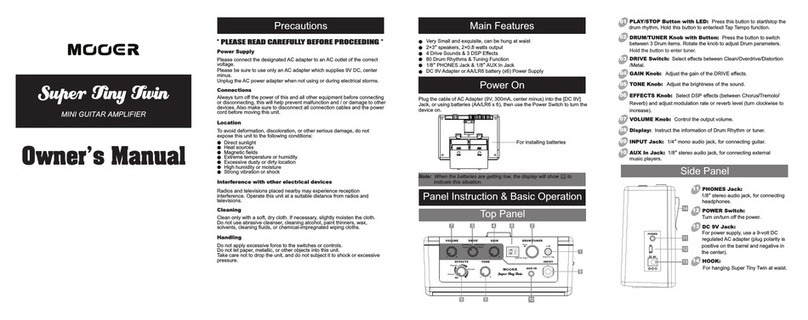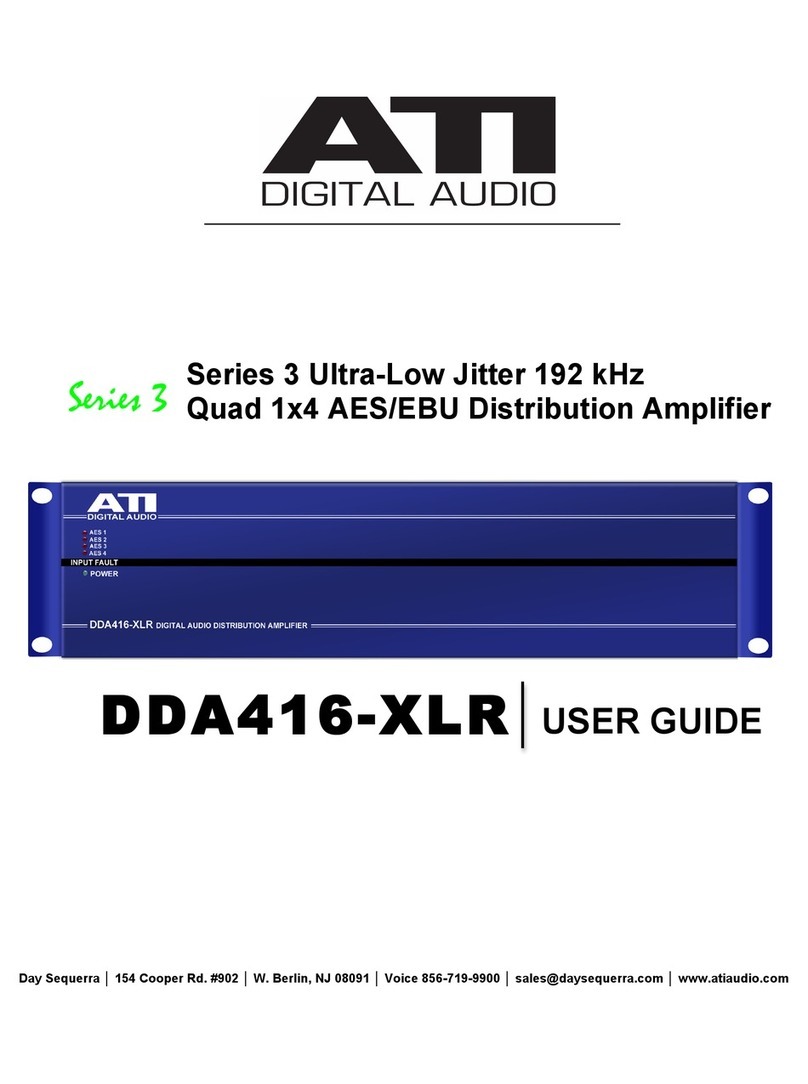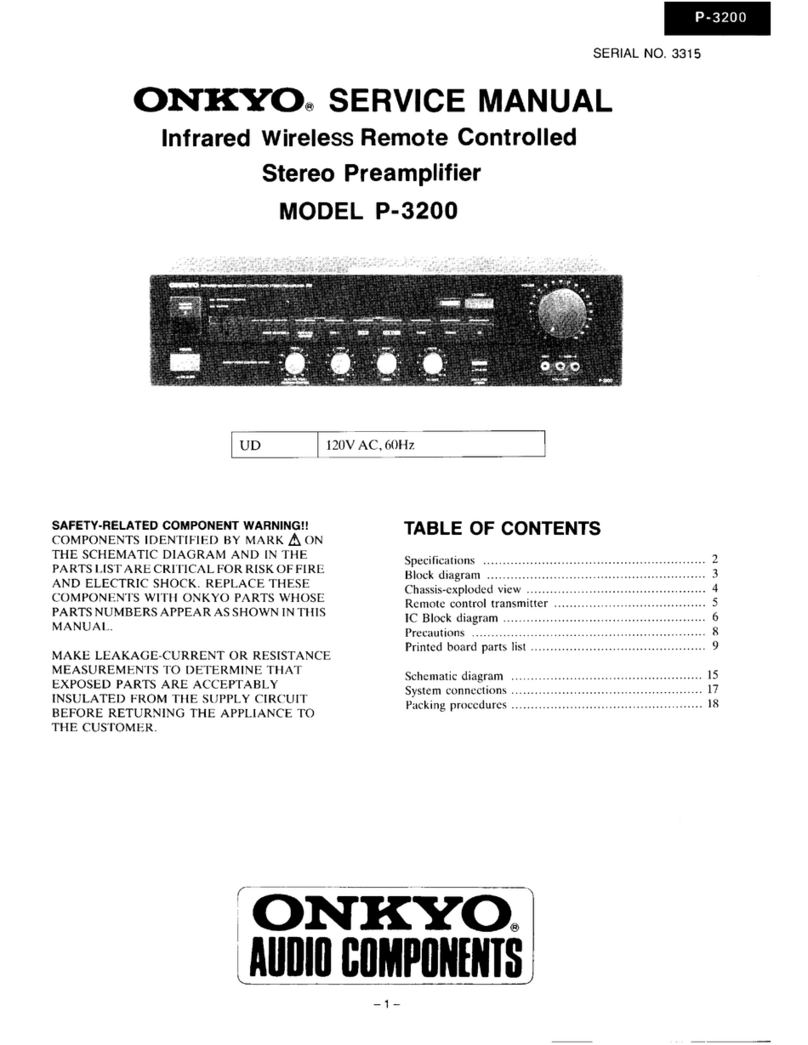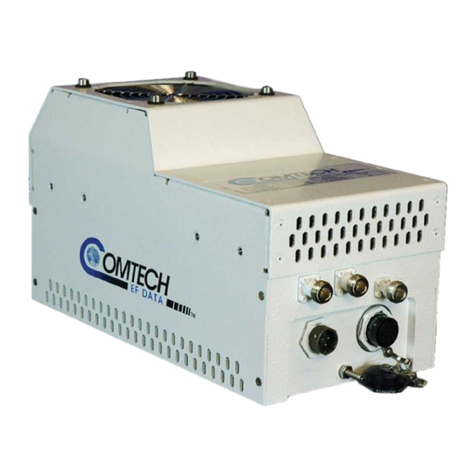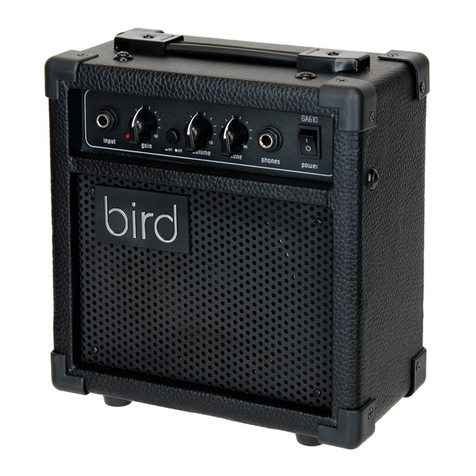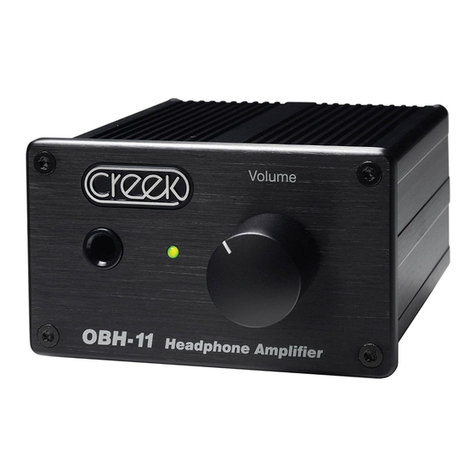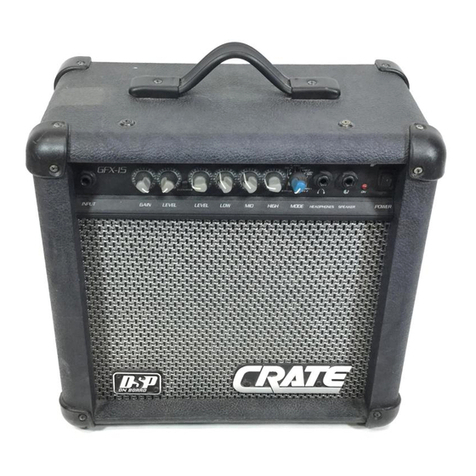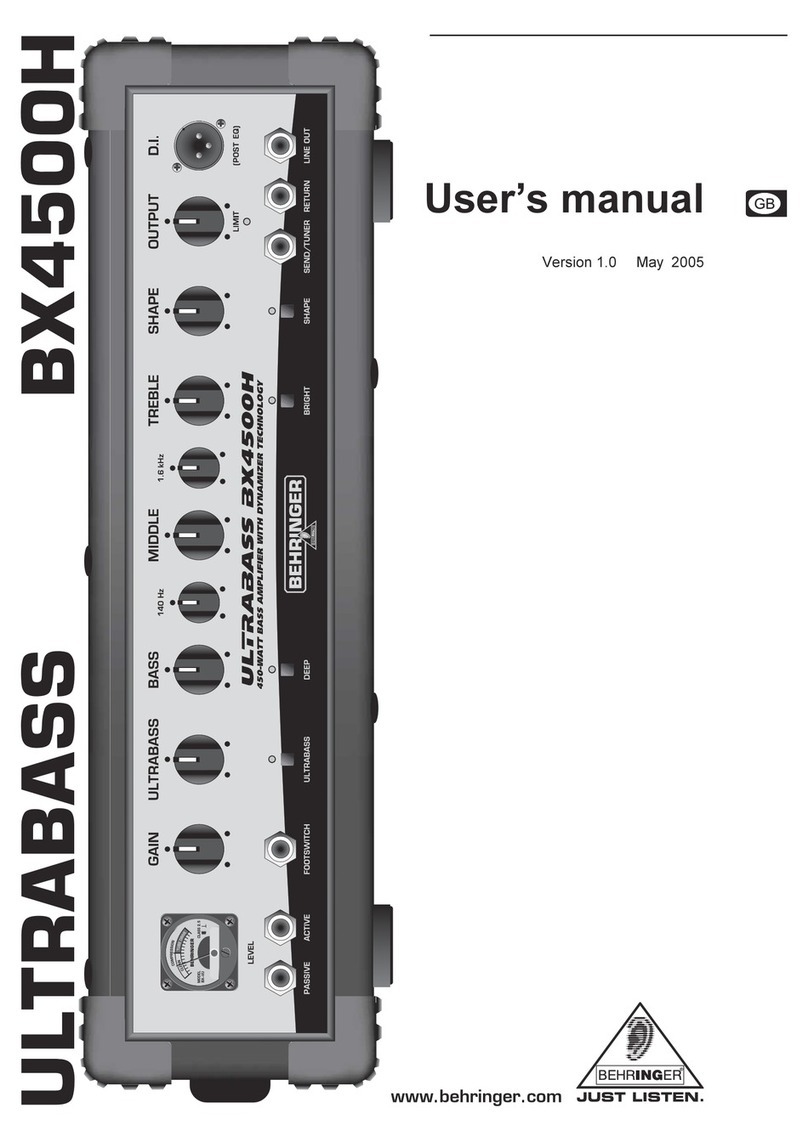Thrax Dionysos User manual


Dionysos
Preamplifier
by Thrax Audio
Operating Manual
Manual issued 05/03/2012
CAUTION
THE UNIT CONTAINS NO USER SERVICEABLE PARTS. DO NOT REMOVE THE COVERS. LETHAL
VOLTAGES ARE PRESENT WITHIN THE CHASSIS.
NEVER OPERATE THE PREAMPLIFIER WITH THE CHASSIS COVERS REMOVED.
DO NOT OPERATE THE UNIT IF WET OR NEAR WATER.
THE PREAMPLIFIER IS FAIRLY HEAVY. BE SURE TO USE PROPER LIFTING TECHNIQUES TO AVOID
BACK STRAIN AND INJURY. BE CERTAIN TO INSTALL IT IN A SECURE LOCATION FROM WHICH
IT CAN NOT FALL OR TIP OVER.
TIME SPENT FAMILIARIZING YOURSELF WITH THIS MANUAL WILL BE WELL REWARDED.

1. Important Safety Instructions …………...................….................................... 3
2. Introduction ………........................................................................................… 4
3. Specification ……..........................................................................................… 5
4. Unpacking and Installation
- Unpacking ……....................................................................................… 6
- Installation ……....................................................................................… 6
5. Front Panel ……..............................................................................................… 7
6. Back Panel
- AC Fuse …….........................................................................................… 9
- Inputs …..…...........................................................................................… 9
- Outputs ………......................................................................................… 9
- Tape output ………............................................................................… 10
9. Remote Control ............................................................................................. 11
8. Operation ……….........................................................................................… 12
CONTENTS
2

READ ALL INSTRUCTIONS: All the safety and operating instructions of your Thrax Audio
equipment should be read before power is applied to the equipment.
RETAIN OWNER'S MANUAL: These safety and operating instructions should be retained
for future reference.
HEED WARNING: All warnings on the unit and in the operating instructions should be
adhered to.
FOLLOW INSTRUCTIONS: All operating and use instructions should be followed.
CLEANING: Unplug the unit from the wall outlet and leave for at least 30 min. - make sure
the unit is not hot before you start cleaning. Use dry or damp soft cloth to clean the
surfaces. Do not use corrosive, abrasive or spray for cleaning.
VENTILATION: Do not block any ventilation openings. Do not install near any heat sources
such as radiators, heat registers, stoves, or other apparatus (including amplifiers). The unit
should not be installed in a built-in location such as a bookcase or rack unless proper
ventilation is provided.
GROUNDING: Do not defeat the safety purpose of the grounding-type plug. A
grounding-type plug has two blades and a third grounding prong. The third prong is
provided for your safety. If the provided plug does not fit into your outlet, consult an
electrician for replacement of the obsolete outlet.
POWER CORD PROTECTION: Protect the power cord from being walked on or pinched
particularly at plugs, convenience receptacles and the point where they exit from the
apparatus.
LIGHTNING: Unplug this apparatus during lightning storms or when unused for long
periods of time.
SERVICING: Refer all servicing to qualified service personnel. Servicing is required when
the apparatus has been damaged in any way, such as if the power-supply cord or plug is
damaged, liquid has been spilled inside the appliance or it has been exposed to
moisture, the appliance does not operate normally, or has been dropped.
DO NOT OPEN THE CABINET: There are no user serviceable components inside this
product. Opening the cabinet may present a shock hazard, and any modification to the
product will void your warranty.
WARNING: To reduce the risk of fire or electric shock, do not expose this apparatus to rain
or moisture.
IMPORTANT SAFETY INSTRUCTIONS
3

The Dionysos preamplifier is the world’s finest audio preamplifier and an absolutely
unique component. It’s unusual topology, premium parts, and flexibility make it a
pleasure to hear and operate.
Dionysos has a single gain stage executed with zero feedback using a triode type vacum
tube. It is transformer coupled eliminating ground loops and isolating the attenuator and
amplification stage from the influences of the outside world (other components).
Features
6 inputs – 4 unbalanced on RCA (independent switching ground) and 2 balanced on
XLR, 4 outputs – 2 unbalanced and 2 balanced (allowing bi - amping), 32 position
stepped volume control, Phase switch normal/inverted, Tape out (switchable),
Programmable Home Theatre (HT) bypass with preset volume on each input, Low
impedance floating outputs (allowing long cables).
Inside you get
Power supply with a C core gapped transformer with symmetrical field canceling
windings.
Tube rectified choke input for the cleanest power, followed by military paper in oil
reservoir capacitors.
Each channel has a constant current fed shunt regulator with extra low noise tube
reference. The amplification stage is a single indirectly heated triode with grounded
cathode, loaded with a transformer.
Microprocessor controlled relays take care of attenuation, phase and input selection
trough a multi tap transformer for volume control.
The case is machined from plates of different thickness aircraft grade aluminum.
INTRODUCTION
4

5
SPECIFICATION
• Inputs
- 4 pair unbalanced RCA connectors
- 2 pair balanced XLR connectors
• Output
- 2 pair unbalanced RCA connectors
- 2 pair balanced XLR connectors
- 1 pair unbalanced RCA connectors – tape out
• Attenuation steps ………………..............................................................…….. 32
• Volume Control Range
- Minimum gain …………….......................................................…….. -46dB
- Maximum gain …………........................................................…….. +18db
• Power supply ………………...................................................... …….. 115 or 230 V
• Power consumption ………..……........................................................…….. 45W
• Dimensions ………………....................................…….. 432W x 400D x 120H mm
• Weight ………………............................................................................…….. 15Kg
• Finish ………………...............................….. Black or Silver anodized aluminum
• Tube compliment :
- 1 x 6H6П amplification
- 1 х 6Ц4П rectifier

This section describes the unpacking and installation procedures for your new
component.
Unpacking
All Thrax Audio shipping boxes have been specially designed to protect their contents
and special care has been taken to prevent damage under normal shipping conditions.
Mishandling should be evident upon inspection of the shipping container. Carefully
remove your new component from its packing and examine it closely for signs of shipping
damage. We strongly recommend saving all original packing to protect your
component from damage should you wish to store it or ship it at a later date.
Installation
• BE CERTAIN TO INSTALL the Unit IN A SECURE LOCATION FROM WHICH IT CAN NOT FALL
OR TIP OVER.
• Provide adequate ventilation - the chassis will become warm in normal use. Do not
operate on carpet or any other surface that might block air flow.
• Do not allow the chassis to touch any metal parts, such as the frame of an equipment
rack. This might create a parallel ground path that could degrade the sound of your
system.
• Connect the input and output cables. Input connection is via single ended RCA jacks
or XLR jacks (which can be from balanced or unbalanced sources). Output can be on
RCA or XLR jacks, and can be set for balanced or unbalanced loads, with or without
ground connection at the preamplifier.
IMPORTANT: READ THE SECTIONS “INPUTS” & “OUTPUTS”.
• The unit should be operated only from the type of power source indicated on the
marking label. If you are not sure of the type of power supplied to your home, consult your
unit dealer or local power company.
Connect the power supply to the power source indicated on the rear panel. Avoid
power conditioners that float the ground pin. ALWAYS connect power cord to
component before plugging it into an AC outlet, and make sure that unit’s power switch
is set to the „off” position before making the final connection. For best performance, try to
route the power cord away from signal cables.
Pay close attention to power quality, and be aware that different power cords can alter
the sound.
UNPACKING AND INSTALLATION
6

Although most of the front panel controls (Volume, Power, Mute) are self explanatory,
Thrax Audio has outfitted this unit with several advanced features which bear further
description:
“ON/OFF” Button
Switches the unit “ON” and “OFF”. See OPERATION SECTION for details.
“TAPE” Button
The “TAPE” button toggles between tape Output “ON” and “OFF”. See “TAPE OUTPUT”
section for detailed information on how the tape output functions. When the LED next
to the tape button is “ON” the tape output is switched on .
“MUTE” Button
This button toggles between mute and normal volume modes. When the LED next to the
mute button is “ON” the system is muted. The mute button on the remote also toggles
mute mode. Adjusting volume via the remote control or the volume knob resets the
preamplifier to not muted mode.
“Left Channel Volume” Display
This numeric display shows the current volume level of the left channel.
In Mute Mode the display reads double dashes “--”.
- The lowest volume level ………………. (level 1) -46 db attenuation
- Unity Gain …………………………....…… (level 24) 0 db attenuation
- The highest volume level …………...… (level 32) +18 db of gain
“Volume” Knob
Not much to say - it’s a volume knob. Turn it clockwise to increase the volume level and
vice verse.
7
FRONT PANEL
Figure 1

“Right Channel Volume” Display
This numeric led displays the current volume of the right channel.
In Mute Mode the display reads double dashes “--”.
- The lowest volume leve l………………. (level 1) -46 db attenuation.
- Unity Gain …………………………....…… (level 24) 0 db attenuation
- The highest volume level …………...… (level 32) +18 db of gain
Just to the right of the Right channel numeric display are the source select functions:
“Input Select Previous” Button
Each button press changes the selected source to the next lower source. If this button is
pressed while source 1 is selected the source wraps around to source 6. The current
source is indicated via a row of LED's just above the source buttons. LEDs may illuminate in
3 different colors – Green, Red and Amber. For details see “Home Theater (HT) Level Set”
and “Phase” Button.
“Phase” Button
Each button press inverts the phase. Green source LED indicates 00 phase. Red source
LED indicates 1800 phase. Phase change works in Home Theatre mode also despite of
source LED is illuminated amber for showing HT mode.
Phase settings for each input are saved in non volatile memory so even after a power
outage this programming will remain stored.
“Input Select Next” Button
Each button press changes the selected source to the next higher source. If this button is
pressed while source 6 is selected the source wraps around to source 1. The current
source is indicated via a row of LED's just above the source buttons.
Source LED's
Above the source/phase buttons are a row of 6 LED's. They indicate the selected source
number. The left most LED is source 1 and the right most led is source 6.
- Green = Normal phase
- Red = Inverted phase
- Amber = Home Theatre
8
FRONT PANEL

BACK PANEL
AC Fuse
There are fuses located in the IEC power connector on the back panel. For 220 volt
operation a 1.0 ampere fuse is used. For 110 volt operation the fuse should be 2.0
amperes. If power does not come on, contact your authorized service representative.
Inputs
4 pairs of RCA jacks accommodate unbalanced line level sources. These are labeled “1”,
“2”, “3” and “4”. Each pair of RCA jack is GND/FLOAT – switchable (see Fig. 2).
For unbalanced sources, you will normally use the RCA “GND” setting. You may also
choose RCA “FLOAT” if it is necessary to break a ground loop.
Inputs “5” and “6” can accept a balanced signal on XLR connectors.
Note: not all sources with XLR connectors are balanced. Many are unbalanced, with pin
2 or pin 3 tied to ground. The preamplifier accepts such sources.
Outputs
Two sets of RCA output jacks are provided as main outputs to power amplifiers. These sets
are equal and are parallel connected internally.
In addition, two pair of XLR jacks can be used to drive a power amplifier. Again, these sets
are equal and are parallel connected internally.
The output selection is set by the “RCA/XLR” switch (see Fig. 2). Incorrect setting will result
in either excessive buzz, or cause gross distortion of frequency response and output. Do
not connect an unbalanced load with “pin 3 hot” to the XLR connectors.
For power amplifiers with RCA input jacks, you will normally use the RCA “GND” setting.
You may also choose RCA “FLOAT” if it is necessary to break a ground loop.
9
Figure 2

BACK PANEL
TAPE Output
There is a set of TAPE output connectors on the back of the preamplifier (see Fig. 2). These
can be used to feed a Tape Deck or CD Recorder input jack. These output jacks are
switched “ON” and “OFF” via a button on the front panel (the TAPE button – as you might
expect, see Fig. 1). When the LED next to the button is on, the TAPE output jacks are
buffered straight from the currently selected input jack at unity gain, just as if you plugged
your source directly into your recorder.
NOTE: This is a bit different than a traditional tape loop. We have chosen this method over
a tape loop because the traditional tape loop introduces additional contacts to the
main signal path all the time - even when the tape function is not used. We prefer to keep
the main signal path as clean as we can and only add features ’around’ that main signal
path.
These switched tape outputs can also be used to feed a headphone amp with its own
built in volume control.
10

11
REMOTE CONTROL
The remote control allows for wireless adjustment of Source Select, MUTE, PHASE,
BALLANCE and VOLUME. The remote wand is powered by two “AAA” batteries. These
should be of the alkaline type. You will need to install them in the wand before using the
remote. Since batteries can leak, they should be removed from the wand if it is not going
to be used for an extended period of time.
Remote Handset Functions
On/off button
This button switches the unit ON / OFF, when in
stand-by mode.
Phase button
This button inverts the source phase
Mute (center of volume/balance grid):
This button toggle between mute and normal
volume modes. When the mute LED is on the
system is muted.
The mute will be canceled when the volume is
adjusted by the remote handset or by the volume
knob on the front of the pre-amp.
Volume Up / Down
The volume up and down buttons step the volume
up or down 1 step (about 2db) per button press or
if held down they continuously adjust volume.
Balance Left / Right
The Balance Left / Right buttons step the volume levels to adjust the balance. This
adjustment moves the sound to the right or left side by 1 volume step per button press (or if
held down continuously balance will progressively move in the desired direction). A
sliding / alternating balance method is implemented to move balance from left or right
and vice verse. This way the overall volume level of the system is maintained. Also you can
slide balance over to one side and then slide it back to the original volume by pressing the
opposite balance button.
Source Select Buttons
The buttons labeled ’1’ through ’6’ on the bottom portion of the remote handset directly
access each of the 6 source inputs on the preamplifier. These direct buttons (rather than
next/prev) are used to make sure that macro functions programmed into a (user
supplied) advanced programmable handset function repeatedly.
On/off
Phase
Mute
Volume
UP / Down
Balance
Left / Right
Source Select
Figure 3

For initial power up press the main switch located on the back panel. Red LED on the front
panel next to the ON/OFF button (see Fig. 1) indicates the unit is now in STANDBY mode.
To switch the preamplifier on press the “ON/OFF” button on the front panel or the ON/OFF
button on the remote control. The red LED indicator blinks for approx 30 sec. whilst the unit
warms up. When ready, the red light turns to green, mute is automatically engaged, and
the last active source will be automatically selected.
The front panel display will be on while the unit is executing a command and then turns
off after a short timeout period.
To turn the preamplifier off press the ON/OFF button. All the amplifier circuitry will be
turned off for minimum power consumption leaving only a small STANDBY circuit running.
However if you are not going to use the amplifier for a long period we recommend
turning it off, using the power switch on the back panel, to save power.
As with all high fidelity products, the sound characteristic changes somewhat as it warms
up. Best sound will be achieved after about 15 minutes of operation.
Any time that the Dionysos Preamplifier has not been used for a few weeks the sound may
be different. This is also normal for high resolution audio equipment. Optimum sound
should return after a few hours of operation, preferably with an audio signal.
Note that although your Thrax Audio System has been run for 72 hours at the factory, it will
continue to ”break in” for approximately 150 hours. Also be aware that many
components display the need for a new break in period after being transported in
unheated cargo aircraft.
Home Theater (HT) Level Set
The “Mute” button on the front panel (see Fig. 1) is used to program the currently selected
input to ’lock’ on any volume level. Press and hold this button for 5 sec. programs the
currently selected input to the current volume level. Pressing the button again for 5 sec.
’unlocks’ the volume setting. The status of each input is shown via that inputs LED on the
front panel: For normal (unlocked) mode the LED is green or red in case the phase is
inverted. For lock (HT) mode the led will turn amber.
The HT mode of each input is saved in non volatile memory so even after a power outage
this programming is stored inside the preamplifier.
Most often this is used to program an input connected to a home theater processor so
that the input will jump to the pre-set level when that input is selected. Each time that
source is selected the level will jump to the programmed level and you use the HT
processors level control to set the volume - which also controls the other channels such as
rear channels, etc...
OPERATION
12

If your HT processor already had its levels set for the same amplifiers directly connected to
the HT Processor then using level 24 (unity gain) on the preamplifier will maintain proper
surround channel vs main channel levels. If you are installing the processor new or making
other changes in the system then you should set the preamplifier to an HT mode for that
processor input BEFORE you set your surround levels. That way the system levels will be
correct each time that input is selected.
The volume could simply be set manually to the same level each time you use that input.
The HT feature is just a handy way to make the level jump automatically to the same
volume each time that input is selected.
NOTE: In some systems switching to an unused input will cause a small amount of hum at
the speakers. This is because with no input connected the signal path is ’hanging in the
breeze’ picking up whatever noise is floating by. For unused inputs HT mode can be
engaged and set to volume level 1 or mute. Then when selected the level is so low that
there will be no hum.
OPERATION
13


NOTES
Table of contents
Other Thrax Amplifier manuals

